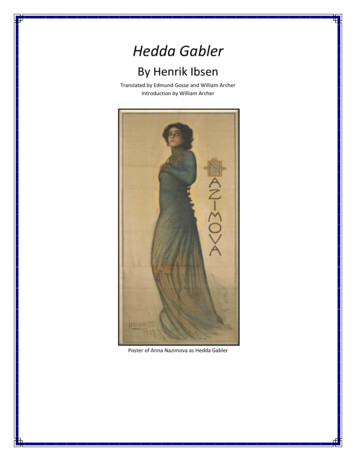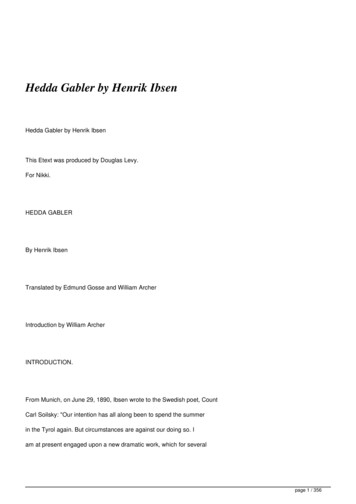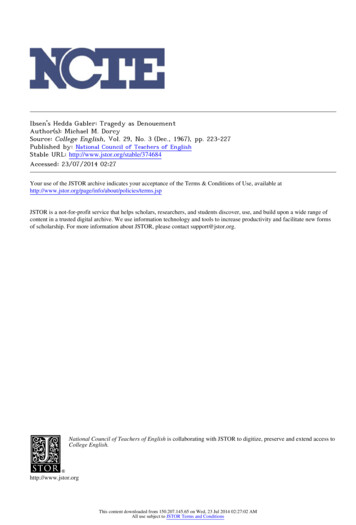
Transcription
Hedda GablerBy Henrik IbsenTranslated by Edmund Gosse and William ArcherIntroduction by William ArcherPoster of Anna Nazimova as Hedda Gabler
Hedda GablerPlay in Four ActsINTRODUCTION. . 3MAIN CHARACTERS . 8ACT FIRST . 9ACT SECOND. 49ACT THIRD . 88ACT FOURTH. 114Page 2 of 137
INTRODUCTION.From Munich, on June 29, 1890, Ibsen wrote to the Swedish poet, Count Carl Soilsky: "Our intentionhas all along been to spend the summer in the Tyrol again. But circumstances are against our doingso. I am at present engaged upon a new dramatic work, which for several reasons has made veryslow progress, and I do not leave Munich until I can take with me the completed first draft. There islittle or no prospect of my being able to complete it in July." Ibsen did not leave Munich at all thatseason. On October 30 he wrote: "At present I am utterly engrossed in a new play. Not one leisurehour have I had for several months." Three weeks later (November 20) he wrote to his Frenchtranslator, Count Prozor: "My new play is finished; the manuscript went off to Copenhagen the daybefore yesterday. It produces a curious feeling of emptiness to be thus suddenly separated from awork which has occupied one's time and thoughts for several months, to the exclusion of all else.But it is a good thing, too, to have done with it. The constant intercourse with the fictitiouspersonages was beginning to make me quite nervous." To the same correspondent he wrote onDecember 4: "The title of the play is Hedda Gabler . My intention in giving it this name was toindicate that Hedda, as a personality, is to be regarded rather as her father's daughter than as herhusband's wife. It was not my desire to deal in this play with so-called problems. What I principallywanted to do was to depict human beings, human emotions, and human destinies, upon agroundwork of certain of the social conditions and principles of the present day."So far we read the history of the play in the official "Correspondence."(1) Some interesting glimpsesinto the poet's moods during the period between the completion of The Lady from the Sea andthe publication of Hedda Gabler are to be found in the series of letters to Fraulein EmilieBardach, of Vienna, published by Dr. George Brandes.(2) This young lady Ibsen met at Gossensass inthe Tyrol in the autumn of 1889. The record of their brief friendship belongs to the history of TheMaster Builder rather than to that of Hedda Gabler , but the allusions to his work in his letters toher during the winter of 1889 demand some examination.So early as October 7, 1889, he writes to her: "A new poem begins to dawn in me. I will execute itthis winter, and try to transfer to it the bright atmosphere of the summer. But I feel that it will endin sadness—such is my nature." Was this "dawning" poem Hedda Gabler ? Or was it rather TheMaster Builder that was germinating in his mind? Who shall say? The latter hypothesis seems themore probable, for it is hard to believe that at any stage in the incubation of Hedda Gabler hecan have conceived it as even beginning in gaiety. A week later, however, he appears to have madeup his mind that the time had not come for the poetic utilisation of his recent experiences. Hewrites on October 15: "Here I sit as usual at my writing-table. Now I would fain work, but am unableto. My fancy, indeed, is very active. But it always wanders away ours. I cannot repress my summermemories—nor do I wish to. I live through my experience again and again and yet again. Totransmute it all into a poem, I find, in the meantime, impossible." Clearly, then, he felt that hisimagination ought to have been engaged on some theme having no relation to his summerexperiences—the theme, no doubt, of Hedda Gabler . In his next letter, dated October 29, hewrites: "Do not be troubled because I cannot, in the meantime, create ( dichten ). In reality I amfor ever creating, or, at any rate, dreaming of something which, when in the fulness of time itripens, will reveal itself as a creation ( Dichtung )." On November 19 he says: "I am very busilyoccupied with preparations for my new poem. I sit almost the whole day at my writing-table. Goout only in the evening for a little while." The five following letters contain no allusion to the play;but on September 18, 1890, he wrote: "My wife and son are at present at Riva, on the Lake ofGarda, and will probably remain there until the middle of October, or even longer. Thus I am quitePage 3 of 137
alone here, and cannot get away. The new play on which I am at present engaged will probably notbe ready until November, though I sit at my writing-table daily, and almost the whole day long."Here ends the history of Hedda Gabler , so far as the poet's letters carry us. Its hard clear outlines,and perhaps somewhat bleak atmosphere, seem to have resulted from a sort of reaction againstthe sentimental "dreamery" begotten of his Gossensass experiences. He sought refuge in the chillmaterialism of Hedda from the ardent transcendentalism of Hilda, whom he already heard knockingat the door. He was not yet in the mood to deal with her on the plane of poetry.(3)Hedda Gabler was published in Copenhagen on December 16, 1890. This was the first of Ibsen'splays to be translated from proof-sheets and published in England and America almostsimultaneously with its first appearance in Scandinavia. The earliest theatrical performance tookplace at the Residenz Theater, Munich, on the last day of January 1891, in the presence of the poet,Frau Conrad-Ramlo playing the title-part. The Lessing Theater, Berlin, followed suit on February 10.Not till February 25 was the play seen in Copenhagen, with Fru Hennings as Hedda. On thefollowing night it was given for the first time in Christiania, the Norwegian Hedda being FrokenConstance Bruun. It was this production which the poet saw when he visited the Christiania Theaterfor the first time after his return to Norway, August 28, 1891. It would take pages to give even thebaldest list of the productions and revivals of Hedda Gabler in Scandinavia and Germany, whereit has always ranked among Ibsen's most popular works. The admirable production of the play byMiss Elizabeth Robins and Miss Marion Lea, at the Vaudeville Theatre, London, April 20, 1891, mayrank as the second great step towards the popularisation of Ibsen in England, the first being theCharrington-Achurch production of A Doll's House in 1889. Miss Robins afterwards repeated herfine performance of Hedda many times, in London, in the English provinces, and in New York. Thecharacter has also been acted in London by Eleonora Duse, and as I write (March, 5, 1907) by Mrs.Patrick Campbell, at the Court Theatre. In Australia and America, Hedda has frequently been actedby Miss Nance O'Neill and other actresses—quite recently by a Russian actress, Madame AllaNazimova, who (playing in English) seems to have made a notable success both in this part and inNora. The first French Hedda Gabler was Mlle. Marthe Brandes, who played the part at theVaudeville Theatre, Paris, on December 17, 1891, the performance being introduced by a lecture byM. Jules Lemaitre. In Holland, in Italy, in Russia, the play has been acted times without number. Inshort (as might easily have been foretold) it has rivalled A Doll's House in world-wide popularity.It has been suggested,(4) I think without sufficient ground, that Ibsen deliberately conceivedHedda Gabler as an "international" play, and that the scene is really the "west end" of anyEuropean city. To me it seems quite clear that Ibsen had Christiania in mind, and the Christiania of asomewhat earlier period than the 'nineties. The electric cars, telephones, and other conspicuousfactors in the life of a modern capital are notably absent from the play. There is no electric light inSecretary Falk's villa. It is still the habit for ladies to return on foot from evening parties, withgallant swains escorting them. This "suburbanism," which so distressed the London critics of 1891,was characteristic of the Christiania Ibsen himself had known in the 'sixties—the Christiania ofLove's Comedy —rather than of the greatly extended and modernised city of the end of thecentury. Moreover Lovborg's allusions to the fiord, and the suggested picture of Sheriff Elvsted, hisfamily and his avocations are all distinctively Norwegian. The truth seems to be very simple—theenvironment and the subsidiary personages are all thoroughly national, but Hedda herself is an"international" type, a product of civilisation by no means peculiar to Norway.We cannot point to any individual model or models who "sat to" Ibsen for the character ofHedda.(5) The late Grant Allen declared that Hedda was "nothing more nor less than the girl wetake down to dinner in London nineteen times out of twenty"; in which case Ibsen must havesuffered from a superfluidity of models, rather than from any difficulty in finding one. But the fact isPage 4 of 137
that in this, as in all other instances, the word "model" must be taken in a very different sense fromthat in which it is commonly used in painting. Ibsen undoubtedly used models for this trait and that,but never for a whole figure. If his characters can be called portraits at all, they are compositeportraits. Even when it seems pretty clear that the initial impulse towards the creation of aparticular character came from some individual, the original figure is entirely transmuted in theprocess of harmonisation with the dramatic scheme. We need not, therefore, look for a definiteprototype of Hedda; but Dr. Brandes shows that two of that lady's exploits were probablysuggested by the anecdotic history of the day.Ibsen had no doubt heard how the wife of a well-known Norwegian composer, in a fit of ragingjealousy excited by her husband's prolonged absence from home, burnt the manuscript of asymphony which he had just finished. The circumstances under which Hedda burns Lovborg'smanuscript are, of course, entirely different and infinitely more dramatic; but here we have merelyanother instance of the dramatisation or "poetisation" of the raw material of life. Again, a still morepainful incident probably came to his knowledge about the same time. A beautiful and veryintellectual woman was married to a well-known man who had been addicted to drink, but hadentirely conquered the vice. One day a mad whim seized her to put his self-mastery and her powerover him to the test. As it happened to be his birthday, she rolled into his study a small keg ofbrandy, and then withdrew. She returned some time after wards to find that he had broached thekeg, and lay insensible on the floor. In this anecdote we cannot but recognise the germ, not only ofHedda's temptation of Lovborg, but of a large part of her character."Thus," says Dr. Brandes, "out of small and scattered traits of reality Ibsen fashioned his close-knitand profoundly thought-out works of art." For the character of Eilert Lovborg, again, Ibsen seemunquestionably to have borrowed several traits from a definite original. A young Danish man ofletters, whom Dr. Brandes calls Holm, was an enthusiastic admirer of Ibsen, and came to be on veryfriendly terms with him. One day Ibsen was astonished to receive, in Munich, a parcel addressedfrom Berlin by this young man, containing, without a word of explanation, a packet of his (Ibsen's)letters, and a photograph which he had presented to Holm. Ibsen brooded and brooded over theincident, and at last came to the conclusion that the young man had intended to return her lettersand photograph to a young lady to whom he was known to be attached, and had in a fit ofaberration mixed up the two objects of his worship. Some time after, Holm appeared at Ibsen'srooms. He talked quite rationally, but professed to have no knowledge whatever of the letterincident, though he admitted the truth of Ibsen's conjecture that the "belle dame sans merci" haddemanded the return of her letters and portrait. Ibsen was determined to get at the root of themystery; and a little inquiry into his young friend's habits revealed the fact that he broke his fast ona bottle of port wine, consumed a bottle of Rhine wine at lunch, of Burgundy at dinner, and finishedoff the evening with one or two more bottles of port. Then he heard, too, how, in the course of anight's carouse, Holm had lost the manuscript of a book; and in these traits he saw the outline ofthe figure of Eilert Lovborg.Some time elapsed, and again Ibsen received a postal packet from Holm. This one contained hiswill, in which Ibsen figured as his residuary legatee. But many other legatees were mentioned in theinstrument—all of them ladies, such as Fraulein Alma Rothbart, of Bremen, and Fraulein EliseKraushaar, of Berlin. The bequests to these meritorious spinsters were so generous that their sumconsiderably exceeded the amount of the testator's property. Ibsen gently but firmly declined theproffered inheritance; but Holm
experiences—the theme, no doubt, of _Hedda Gabler_. In his next letter, dated October 29, he writes: "Do not be troubled because I cannot, in the meantime, create (_dichten_). In reality I am for ever creating, or, at any rate, dreaming of something which, when in the fulness of time it ripens, will reveal itself as a creation (_Dichtung_)." On November 19 he says: "I am very busily occupied .











